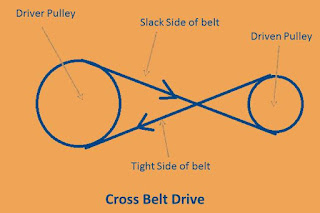Introduction :
To transmit power from one shaft to another pulley are mounted on the two shafts. The pulleys are then connected by an endless belt or rope passing over the pulleys. The connecting belt or rope is kept in tension so that the motion of one pulley is transferred to the other without slip. The speed of the driven shaft can be varied by wearing the diameter of the two pulleys.
What is belt drive?
Belt the drive is a mechanism in which power is transmitted by the movement of a continuous flexible belt.
A belt may be a rectangular section is known as a flat belt or of the trapezoidal section known as V-belt. In case of a flat belt, the rim of the
pulley is slightly crowned which helps to keep the belt running centrally on
the pulley rim. The groove on the rim of the pulley of a V-belt is made deeper
to take advantage of the wedge action. The belt does not touch the
bottom of a groove. Owing to wedging action V-belt needs a little adjustment and
transmit more power without sleep as compared to flat belt also multiple V-belt a system using more than one belt in the two pulleys can be used to increase the
power transmitting capacity generally these are more suitable for shorter
centre distance. Thus, belt drive works on the law of belting.
Open belt drive :
An open belt drive used when the driven pulley is desired to be rotated in the same direction as the driving pulley.
Generally, the centre distance for an open belt drive is 14 to 16 metre.
If the centre distance is too large, the belt whips vibrate in a direction
perpendicular to the direction of motion. For very short at the centre distance, the belt sleep increasing. Both these phenomena limit the use of belts for
power transmission.
Crossbelt drive :
A the crossed-belt drive is adopted when the driven pulley is to be rotated in the opposite direction to that of the driving pulley.
A cross belt drive can transmit more
power than an open belt drive as the angle of wrap is more. However, the belt
has to be a band in two different planes and it we are out more.
Advantages of belt drive :
- A belt drive is simple and economical.
- Wide range of speeds is available.
- In belt drive don't need parallel shaft.
- Noise and vibration are damped out.
- Machinery life is increased because load fluctuations are shock-absorbed.
- Less maintenance cost because no lubrication are required.
- Belts permit flexibility ranging from high horsepower drives to slow speed and high speed drives so it is highly efficient in use.
- A flat belt is best for very high-speed drives.
- This drive is very economical even when the distance between the shaft is very large.
- Belts will slip under overload conditions this leads the biggest advantages that preventing mechanical damage to shafts, keys, and other machine parts.
- All the belt drives do not need the pulleys to be maintained at the same height.
Disadvantages of belt drive :
- Operating temperature is restricted up to 80 to 850C.
- Heat buildup occurs.
- Belts can't be used where exact timing or speed is required because of slippage.
- Because of slipping and stretching the angular velocity ratio is not necessarily equal or constant to pulley diameter ratio.
- In belt, drive belts are damaged easily by abrasives or heat or some chemicals.
- Some adjustment of centre distance or use of an idler pulley is necessary for wearing and stretching of belt drive compensation.
- Speed is limited to usually 35 meters per second.
- Power transmission is limited to 370 kilowatts.


